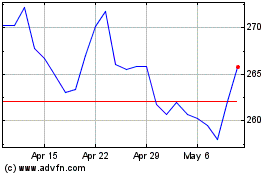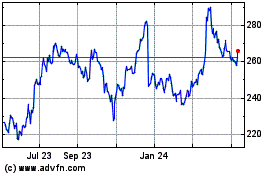Today's Logistics Report: Setting New Driving Hours; FedEx's Retail Limits; Freight Trains from China
May 15 2020 - 1:39PM
Dow Jones News
By Paul Page
Sign up: With one click, get this newsletter delivered to your
inbox.
Highway safety regulators are hoping new flexibility in the
rules governing truckers' time behind the wheel puts to rest years
of argument over the driving limitations. The regulation that takes
effect in September provides more leeway in freight transport
operations, the WSJ Logistics Report's Jennifer Smith writes, and
could save trucking companies nearly $274 million annually over the
next 10 years. Shippers may expect the savings to be passed along
through lower rates, but the bigger benefit will come from having a
less rigid clock on operations. That includes allowing drivers to
split 10 hours in mandated off-duty time into two separate breaks
and exempting some duty time that isn't spent driving from hours
limitations. The Teamsters union says that provision could put
fatigued drivers on the road. The main independent drivers' group
supports the new rule, however, and so do groups representing the
large trucking companies.
E-COMMERCE
New distribution strategies retailers are undertaking to survive
the coronavirus pandemic are triggering turmoil in parcel-delivery
networks. FedEx Corp. has started to limit the number of items that
several big stores including Kohl's Corp. can ship from certain
locations, the WSJ's Paul Ziobro reports, as the carrier tries to
prevent its network from being overwhelmed by sharp swings in the
flow of goods. FedEx's action highlights the strains on parcel
operations as consumers have rushed to e-commerce while sheltering
at home. Retailers are responding by turning their stores into
makeshift warehouses, scrambling the normal flow of online
shipments from distribution centers to homes. FedEx compares the
limits to its holiday peak-season operations. But the company and
other parcel carriers may have to change their operations over the
long term if retailers and consumers like the shopping and
fulfillment practice and keep it going after the pandemic.
QUOTABLE
TRANSPORTATION
The burgeoning freight rail corridor connecting China to Europe
is getting a coronavirus-driven boost in demand. Growing numbers of
shippers are moving to the core element of China's Belt and Road
Initiative, the WSJ's Trefor Moss reports, as rising prices and
disruptions in ocean and air transport have companies turning to
trains. China Railway Corp., which operates the trains in China,
says it ran 976 trips in April, up 47% from last year. The trains
carried the equivalent of the capacity of four of the world's
largest container ships. Shenzhen-based logistics company
Chinatrans International says new customers are coming in
"desperate" because airfreight prices have been soaring and
container shipping lines are cutting sailings. The rail services
have bulked up capacity in the meantime, giving the transport
initiative a new audience among clothing suppliers and auto-parts
companies that could last beyond the pandemic.
LOGISTICS TECHNOLOGY
The robots may be getting ready to help with social distancing
in stores. Grocer Koninklijke Ahold Delhaize NV is accelerating
development of a robotic arm because Covid-19 created an urgent
need for technology to help workers clean stores and process
orders. The WSJ's Catherine Stupp writes that researchers in the
Netherlands are testing the technology, which could be rolled
across company operations that include stores in Europe and the
U.S. It's a sign of how some companies appear to be stepping up
automation efforts as as they adjust to the economic pressures of
the coronavirus pandemic. Ahold Delhaize's robotic arm is the
latest attempt to solve the robotics logistics challenge over how
to handle different goods with a wide variety of shapes and
textures. The research group's artificial intelligence team is
focusing on improving the robotic arm's ability to identify and
hold different products like fruits without damaging them.
IN OTHER NEWS
Nearly 3 million more Americans applied for unemployment
benefits. (WSJ)
The Trump administration plans to expand the nation's stockpile
of medical equipment to include 90 days' worth of supplies to
prepare for potential viral outbreaks. (WSJ)
China's Industrial output rebounded last month, growing 3.9%
from a year earlier. (WSJ)
Contract manufacturing giant Taiwan Semiconductor Manufacturing
plans to build a $12 billion advanced chip factory in Arizona.
(WSJ)
Delta Air Lines is retiring its 18 Boeing wide-body 777 jets by
the end of the year to preserve cash. (WSJ)
Airline Virgin Atlantic is talking to banks about raising some
$916 million to help it weather the coronavirus-driven drop in
demand. (WSJ)
Whirlpool, Dow and Reynolds Consumer Products are collaborating
to provide respirators for front-line health-care workers.
(WSJ)
New York City lawmakers passed measures capping delivery fees
charged by services like Grubhub and prohibiting charges for
undelivered food. (WSJ)
Apple supplier Foxconn Technology Group's first-quarter net
profit slumped 90% from a year ago. (WSJ)
China exempted another 79 U.S. products from import tariffs.
(South China Morning Post)
Investors are flocking to funds focused on logistics facilities
in Asia in anticipation of booming post-coronavirus demand for
e-commerce facilities. (Nikkei Asian Review)
The U.S. Postal Service is reviewing its package delivery
contracts with major private parcel companies. (Washington
Post)
Taiwanese container line Yang Ming lost $27.2 million in the
first quarter on a 4% drop in container volume. (Lloyd's List)
Singapore Airlines lost $212 million in the year ending March
31, the first annual loss in its 48-year history. (Straits
Times)
The family of a Florida woman killed by a delivery driver
dropped a lawsuit against Best Buy, J.B. Hunt Transport Services
and XM Delivery. (Palm Beach Post)
ABOUT US
Paul Page is editor of WSJ Logistics Report. Follow the WSJ
Logistics Report team: @PaulPage , @jensmithWSJ and @CostasParis.
Follow the WSJ Logistics Report on Twitter at @WSJLogistics.
Write to Paul Page at paul.page@wsj.com
(END) Dow Jones Newswires
May 15, 2020 13:24 ET (17:24 GMT)
Copyright (c) 2020 Dow Jones & Company, Inc.
FedEx (NYSE:FDX)
Historical Stock Chart
From Mar 2024 to Apr 2024

FedEx (NYSE:FDX)
Historical Stock Chart
From Apr 2023 to Apr 2024
